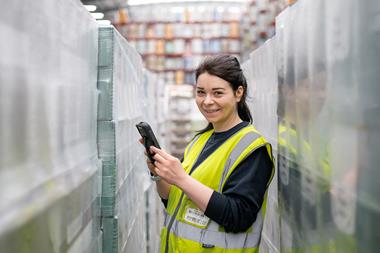The food and drink sector might be abuzz at all the potential in AI right now, but many brands and retailers remain stuck on fragmented use cases, adding cost and complexity without the promised productivity gains. For the next installment in our series on unlocking value, we explore what needs to change?
From self-checkouts that spot shoplifters, to ‘virtual conversational assistants’ and AI-generated Christmas campaigns, the UK grocery sector is awash with investments being made by brands and retailers into artificial intelligence (AI) right now.
According to KPMG’s Intelligent Retail report, more than half (56%) of retailers say they’ve been leveraging AI across their business for three years, with two thirds (67%) confident that levels of spending on AI-driven initiatives will ‘significantly’ increase within the next 12 months.
But despite high levels of adoption, often investments in AI within food and drink remain focused on piloting flashy use cases, rather than taking the time to understand and unlock the full potential in the tech, say experts.
There are different models that work, but interestingly only a fifth (19%) of retailers have a specialised AI team driving coordinated adoption across the organisation right now, relying instead on fragmented models and applications, according to KPMG. If so, a truly transformative outcome from AI across the enterprise seems challenging.
So, how can businesses build a strategy for AI that does more than attract a bit of short-lived hype?
Building trust through enablement
“At it’s core, AI is a powerful enabler of business transformation, with potential to deliver significant growth and efficiencies for organisations,” outlines Ben Cobb, director of technology strategy at KPMG UK. “The real value from AI comes when it’s being used to connect across the enterprise at scale, rather than in functional silos.”
The first tier, Enablement, is where many brands and retailers likely find themselves. This sees AI used to complement or enable existing processes and could include the use of enterprise-wide generative AI solutions like Microsoft Teams Copilot, or in narrow functional use cases like payroll anomaly detection.
Productivity gains here are likely to be small, according to Cobb, but it’s important not to skip this stage either. “It’s vital that organisations don’t skip the ‘Enable’ phase of their AI journey, as it’s as much about the cultural adoption and building trust in the use of AI in these early stages as it is about the individual productivity gains,” he says.
In fact, with less than half of consumers globally (46%) still willing to trust AI systems, according to KPMG’s own global survey of AI attitudes across 48,000 people in 47 countries, establishing that trust from customers and colleagues first is crucial.
“AI is ensuring customers are shown the right products at the right time to boost engagement, drive loyalty, and encourage repeat purchases”
Matt Hildon, European retail director, Valtech
As a result, piloting applications that visibly enhance customer experience (CX) could be a strategic route, suggests Matt Hildon, European retail director at Valtech. “This could include Intelligent Assistants - a significant leap beyond traditional chatbots - offering faster, more helpful customer support,” he says. Or “on the marketing front, hyper-personalised campaigns are becoming the norm. AI is ensuring customers are shown the right products at the right time to boost engagement, drive loyalty, and encourage repeat purchases.”
Read more in the series:
-
Risk vs reward: how brands and retailers can grow without the gamble in 2025
-
The ‘virtuous circle’: how to deliver personalisation and privacy
-
How brands and retailers can win with data
When surplus marketplace Too Good to Go designed its end-to-end surplus food management software solution last year, for example, the impetus was less about headline-grabbing features, and more about identifying pain spots for the retail customers it works with, says Sid Baveja, its vice president of operations for central Europe, the UK and Ireland.
“With priority to how we can help our partners improve operational efficiency and improved business impact, we developed features such as our AI-powered discounting module, which utilises data to apply the right discount at the right time,” he says. Additionally, our Expiry Date Management module detects products that are close to expiry and recommends the next best action, whether that be to apply a discount or re-distribute – saving time, revenue and food simultaneously.”

Moving from siloes to scale
Get stuck on the Enablement stage though and brands and retailers risk missing out on the far more significant value gains that AI can deliver when implemented at scale, notes Cobb. He dubs this second tier ‘Embed.’ It refers to brands and retailers using those early insights and starting to use AI solutions to reengineer processes and scale AI across operations, at which point organisations may start to see more significant productivity gains.
“Businesses need to be able to scale successful AI proof-of-concepts (POCs) and embed them into production platforms at speed, so they can demonstrate their value as soon as possible,” agrees Hildon.
This step could include optimising a particular function with AI, such as refining the balance between availability, cost and waste within supply chains or in estate planning. “Already we’re seeing some large grocery retailers use AI analytics to inform store layouts and which products to stock where,” says Cobb.
“They can now make complex strategic decisions by leveraging AI to answer questions, such as “where should we invest in new store locations?’ ‘what products should we stock and where should they be placed for maximum value?’” he adds. “AI can enable them to answer these questions with a high degree of accuracy in minutes, instead of weeks.”
As part of a five-year strategic partnership with Microsoft for example, Sainsburys has begun using the technology to create smarter shelf replenishment processes. By drawing real-time data from shelf-edge cameras, AI is being used by the grocer to guide store staff toward shelves that require restocking, ensuring fewer sales opportunities are missed due to lack of availability and leaving its staff more time to focus on in-the-moment customer queries.
Evolving to enterprise-level adoption
By far and away the biggest gains to be achieved via AI lie in the third and final stage of adoption though, a step he calls ‘Evolve’, this is a new mindset, and is where organisations can start to target the significant productivity gains, says Cobb.
This sees brands and retailers develop an enterprise-wide strategy that includes front office enhancements enabled by an optimised back office and the entire workforce AI-enabled. Rather than a complementary tool to enhance existing processes, AI becomes a tool for delivering brand new functions that wouldn’t have been possible prior to the tech.
Despite the gains, it’s here where many brands and retailers hit a roadblock, he adds, often battling a lack of data readiness, AI literacy or legacy tech.
“Successfully implementing AI involves an enterprise-level strategy approach building capability across every layer of the business”
Ben Cobb, director of technology strategy, KPMG
There are some exceptions though. For example, last year Danone announced a multi-year collaboration with Microsoft to integrate AI throughout its operations, including an academy dedicated to upskilling its employees. “Adopting AI at an enterprise level ensures holistic integration, scalability, and cost efficiency management, to enhanced decision-making,” says Axel Droin, its director of data and AI product. “We believe that adopting common technologies, versus a siloed approach, fosters innovation, cross-collaboration between teams, and improves operational efficiency.
“Additionally, enterprise-level AI adoption enables comprehensive upskilling initiatives at scale,” he adds. “By training employees across all departments on the same tools and technologies, Danone ensures that the workforce is equipped with the necessary skills to leverage AI effectively, fostering a culture of continuous learning and innovation.”
Reach for AI’s Holy Grail
It might be an uphill climb, but every brand and retailer should be aiming for this third and final stage of AI adoption in the coming years, says Cobb.
“Successfully implementing AI involves an enterprise-level strategy approach building capability across every layer of the business,” he explains. “Ultimately, you can drive more value by embedding it across the business, with end-to-end value streams or processes that fully connect data and insights in a joined-up way.”
The bottom line is that brands and retailers need to increasingly move away from experimentation and toward strategic, scaled-up integration if they’re to unlock the real value in AI.
It might not land a flashy headline, but it could prove transformative for growth.
To learn more about how KPMG’s experts can help your business, visit: KPMG Consumer
Or contact:
Linda Ellett, partner, head of consumer, retail and leisure: Linda.Ellett@kpmg.co.uk, or
Ben Cobb, director of technology strategy: Ben.Cobb@kpmg.co.uk

Risk vs reward: how brands and retailers can grow without the gamble in 2025

As the food and drink industry moves into 2025, brands and retailers continue to weigh up the opportunities afforded by innovation alongside maintaining a positive sales performance – and it’s a tricky balance to achieve. Discover why careful deliberation and the use of data and technology are vital to ensure ...
- 1
- 2
- 3
 Currently
reading
Currently
reading
Beyond the buzz: It’s time brands and retailers rethink how they use AI
- 5
- 6

































